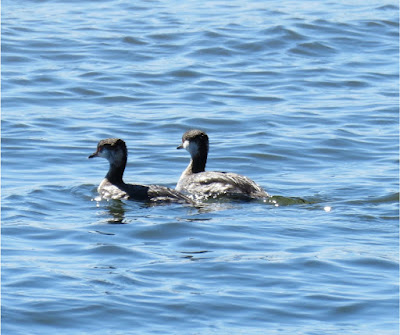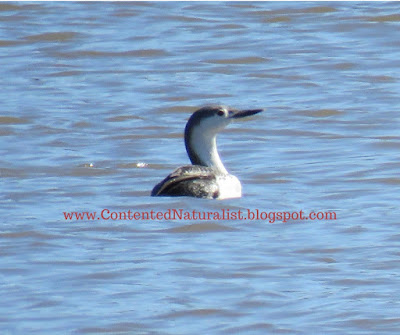With spring nearly upon us,
and the weather starting to warm (just a bit), the ducks that have wintered
here are about to head north. That means, of course, that the time remaining to
see them is dwindling. But it also means birders might luck into a few rarities
that drop in for a few days of rest on their northward migration.
With that in mind, and having
seen recent alerts from eBird about a Red-necked Grebe near the C&O Canal,
Victor and I decided to bird a bit of the C&O this weekend. The weather was
gorgeous when we set out—clear and sunny, a bit cool still but great for
hiking. The grebe had been reported at both Violette’s Lock and Riley’s Lock,
just a mile or so apart. We’ve seen huge gatherings of wood frogs near Violette’s
Lock before, so started there, hoping maybe a few frogs would have ventured out
of hibernation already. But the creek lacked any indication of mating frogs
when we were there, so no luck on the amphibian front. On we went to birding.
I scanned the stretch of the
Potomac for any interesting birds. Dozens of gulls studded the water (probably
all Ring-billed, although I didn’t examine every single individual), but no
interesting waterfowl could be seen. We headed downstream along the trail,
stopping any time a break in the trees gave a good look at the river. Still,
however, nothing but gulls. We encountered another birder heading upstream; he
told us Horned Grebes and a Ruddy Duck were at Riley’s Lock, but he hadn’t been
able to find the Red-necked Grebe. We wished him good birding, and kept hiking.
 |
| One of the many Ring-billed Gulls we saw that day |
When we reached Riley’s Lock,
we found that four Horned Grebes were indeed present and easily found. They only
stayed above water for a few seconds at a time, though, frequently diving after
minnows. This made close observation and photography tough, but thankfully
Victor got some decent pictures. We left the lock and continued upstream.
 |
| Two Horned Grebes in between dives. |
Soon I spotted a few nice
songbirds in the trees—several Bluebirds and Yellow-rumped Warblers among them.
I didn’t see any early migrating warblers (the Yellow-rumps are here
year-round), but they were still nice ticks. We also found a few Gadwall and
Mallards enjoying the sunshine in a pond.
 |
| This Yellow-rumped Warbler seemed to be examining us as much as I observed it! |
 |
| A male & a female Gadwall on the muddy pond. The male's black butt is a handy field mark. |
On our way back, the horned
grebes were still at Riley’s Lock, and had been joined by a much larger bird.
This new bird had a longer, heavier bill, and had more white on the front of
its neck. Could it be my longed-for Red-necked Grebe? I convinced myself it
was, and even logged it in eBird and told another birder we encountered when we
were almost back to our car. I was so excited I neglected to check for other
possible IDs.
 |
| The way this bird tilts its bill upward is one of the key field marks for the Red-throated Loon in winter. I should have realized that, if I'd bothered to think about other possible IDs. |
 |
| Another view of the loon, still tilting its bill upward. The throat is only red in breeding plumage, seen in the summertime. |
It wasn’t until I got home
and checked our photos that I realized we had actually spotted a Red-Throated
Loon, also listed as rare for our area this time of year. I had to edit my
ebird checklist to correct my mistake. It’s correct in their data base now, but
I still feel embarrassed about jumping to conclusions. Moral of the story: just
because you wanted to find a particular species doesn’t mean you did!
Always double check your ID and rule out other possibilities, before declaring you’ve spotted a lifer bird. I wish I'd done that before reporting the Red-necked Grebe on eBird!
So I never did spot the
Red-necked Grebe that day, but I think the loon was a decent consolation prize.
Kind of a funny coincidence that they both had “Red” in their name. It made my
91st bird species for the year, and the Horned Grebes were my 90th.
I’m almost half-way to my goal of 200 bird species for the year! I know the
more I get, the harder it will be to add a new species. I’m still hoping to
make that nice fat number by December 31, though.
Are you seeing any
interesting birds in your area as the spring migration gets started? I’d love
to hear about them in the comments. Also, please let me know if you have any
questions about birdwatching or birding equipment. I’ve been birding for most
of my life, so I may have forgotten what it’s like to be a beginning birder. But
I’d love to help you all get started or become more advanced birders!

Thanks for sharing your mistakes as well as your positive ID's with us, Jodi! We've all been there. Appreciate your great observations on the natural world.
ReplyDeleteHi Tuesdays in the Tallgrass, yep, this isn't exactly the first time I've been wrong on an ID either. But that's all part of the challenge and the fun! Thanks for your kind comment.
ReplyDelete